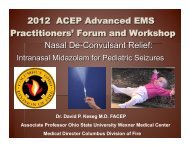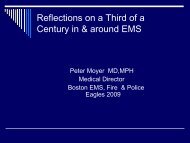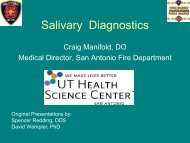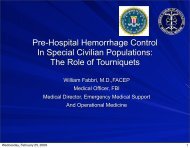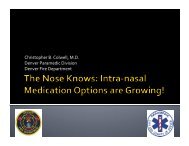Dr. Neal Richmond - The Urge To Surge - Gathering of Eagles
Dr. Neal Richmond - The Urge To Surge - Gathering of Eagles
Dr. Neal Richmond - The Urge To Surge - Gathering of Eagles
You also want an ePaper? Increase the reach of your titles
YUMPU automatically turns print PDFs into web optimized ePapers that Google loves.
<strong>Neal</strong> J. <strong>Richmond</strong>, M.D. FACEP<br />
Louisville Metro EMS<br />
Thursday, February 26, 2009<br />
1
<strong>The</strong> train is coming<br />
bells & whistles probably won’t help a<br />
whole lot<br />
Thursday, February 26, 2009<br />
2
Madrid Commuter Train Attack<br />
Election eve March 11,<br />
2004<br />
10 bombs exploded<br />
4 commuter trains<br />
During rush-hour<br />
177 killed instantly<br />
2000 injured<br />
1000 patients transported<br />
to 15 hospitals<br />
270 patients arrived at a<br />
single hospital ER within 3-<br />
hours<br />
89 required admission<br />
29 required critical care<br />
3<br />
Thursday, February 26, 2009
U.S. House <strong>of</strong> Representatives Committee<br />
on Oversight & Government Reform<br />
Evaluate nation’s preparedness for surge<br />
Is the emergency care system in the U.S.<br />
prepared to respond to a terrorist attack?<br />
Do major cities in this country have the<br />
capacity to respond to the same level <strong>of</strong><br />
casualties as was seen in Madrid?<br />
Thursday, February 26, 2009<br />
4
Survey <strong>of</strong> Level-1 Trauma Centers<br />
Five at highest risk <strong>of</strong> a terrorist strike<br />
Two where the 2008 DNC and RNC were<br />
held<br />
Thursday, February 26, 2009<br />
5
Study design <br />
Federal resources will require > 72-hours to<br />
deploy<br />
So local ERs & trauma centers will provide main<br />
access<br />
Most likely scenario for a terrorist strike<br />
Large number <strong>of</strong> traumatic injuries<br />
2° to conventional explosives<br />
Paradigm <strong>of</strong> Golden-hour <strong>of</strong> trauma<br />
Treating patients in Level-1 trauma<br />
Highest level <strong>of</strong> injury care<br />
Lowest risk <strong>of</strong> disability & death (25%<br />
reduction)<br />
Thursday, February 26, 2009<br />
6
A Little Context<br />
Last 2o years<br />
Disasters claimed 3-million lives<br />
Adversely affected 8-million more<br />
93 terrorist attacks from 1991-2000<br />
Explosive devices<br />
Most commonly used terrorist weapon<br />
Traumatic injury is most likely the primary<br />
result<br />
52 Centers for Public Health<br />
Preparedness<br />
Focusing on bioterrorism<br />
None focusing on civilian effects <strong>of</strong><br />
Thursday, February 26, 2009<br />
7
Survey Methodology<br />
Snapshot<br />
34 <strong>of</strong> 41 level-1 trauma centers (83%)<br />
participated > 20% <strong>of</strong> total emergency care<br />
capacity<br />
Designed to determine real-time ‘surgecapacity’<br />
Emergency rooms, critical-care & inpatient units<br />
<strong>To</strong> absorb a sudden influx <strong>of</strong> patients<br />
From a mass-casualty event<br />
Of the Madrid-type<br />
At a precise moment<br />
Thursday, February 26, 2009<br />
8
ER capacity<br />
Survey results<br />
½ <strong>of</strong> the Level-1 ERs operating above<br />
capacity<br />
With the average ER operating at 115%<br />
capability<br />
Not counting patients in the waiting room<br />
And with 15% <strong>of</strong> patients already being seen in<br />
overflow areas<br />
Hallways, waiting rooms, <strong>of</strong>fices<br />
Thursday, February 26, 2009<br />
9
Survey Results<br />
ER capacity<br />
Of 16 level-1 trauma centers in NYC<br />
No space available in 1o<br />
Only 56 ER beds available citywide<br />
< 21% <strong>of</strong> the surge absorbed by a single hospital<br />
in Madrid<br />
5 Level-1 trauma centers in L.A.<br />
3 hospitals were on diversion<br />
Only 6 ER beds were available city-wide<br />
No available level-1 ER beds in D.C.<br />
1 <strong>of</strong> these centers operating at 286% <strong>of</strong> its<br />
Thursday, February 26, 2009<br />
10
Survey Results<br />
ER capacity: boarders<br />
Hospital full = ER patients can’t be<br />
moved<br />
Bottleneck creates ‘boarders’<br />
Limits already strained resources<br />
Boarders in 25% 0f all ER beds in the 7<br />
cities<br />
60% <strong>of</strong> the level-1 beds in D.C.<br />
6/8 hospitals with boarding > 24-<br />
hours in NYC<br />
Thursday, February 26, 2009<br />
11
Survey Results<br />
ER surge capacity: bottom Line<br />
Of all trauma centers surveyed<br />
Not a single facility had sufficient capacity<br />
<strong>To</strong> absorb more than 10% <strong>of</strong> the surge<br />
Single hospital In Madrid<br />
Even with pooling resources<br />
Not one city in the U.S. had sufficient<br />
capacity<br />
Altogether the total # available ER beds<br />
in all 7 U.S. cities<br />
< 1/8 the total # cases transported in Madrid<br />
Thursday, February 26, 2009<br />
12
Survey Results<br />
Critical-care capacity (ICU beds)<br />
29 patients arrived in critical condition<br />
At a single hospital in Madrid<br />
No U.S. level-1 center had sufficient<br />
capacity<br />
Average <strong>of</strong> 5 ICU beds available in each<br />
center<br />
Six hospitals (18%) had no available beds<br />
Even with all trauma center ICU beds<br />
pooled<br />
Thursday, February 26, 2009<br />
13
Survey Results<br />
Inpatient capacity<br />
89 patients<br />
Required admission to an inpatient bed<br />
At a single hospital in Madrid<br />
No U.S. level-1 center had sufficient<br />
capacity<br />
Average <strong>of</strong> 24 inpatient beds available<br />
Thursday, February 26, 2009<br />
14
So what do you do?<br />
<br />
Potential strategies for dealing with<br />
surge<br />
Clean house<br />
Increase hospital capacity<br />
‘Better’ management<br />
Spend more money, but spend it<br />
better<br />
Thursday, February 26, 2009<br />
15
Strategies for <strong>Surge</strong><br />
Clean House<br />
Of the 270 patients who went to one<br />
hospital<br />
123 patients discharged from the ER<br />
161 in-patients d/c’d home (9% <strong>of</strong> 1800<br />
beds)<br />
How many <strong>of</strong> our hospitals could pull<br />
this <strong>of</strong>f ?<br />
Thursday, February 26, 2009<br />
16
Strategies for <strong>Surge</strong><br />
Increasing hospital capacity<br />
Might remedy ER congestion &<br />
overcrowding<br />
But, ‘If you build it and they will come’<br />
More elective treatments & surgeries<br />
scheduled ?<br />
Thursday, February 26, 2009<br />
17
Strategies for <strong>Surge</strong><br />
‘Better’ Management: Reduce ER<br />
overcrowding without building extra<br />
capacity<br />
Reduce or eliminate diversion<br />
Reduce ER boarding with better<br />
through-put<br />
Thursday, February 26, 2009<br />
18
Strategies for <strong>Surge</strong><br />
Reduce or eliminate diversion<br />
Israel, Massachusetts<br />
Diversion is bad (No diversion is good)<br />
Continuity <strong>of</strong> patient care<br />
Utilization <strong>of</strong> EMS resources<br />
Shifting <strong>of</strong> over-crowding<br />
<strong>The</strong> old ‘Yin-Yang: No diversion is<br />
also bad<br />
Safety valve vs. crutch for hospitals<br />
Studies: Increased EMS turn-around times<br />
Thursday, February 26, 2009<br />
19
Strategies for <strong>Surge</strong><br />
‘Better’ Management<br />
Reduce ER ‘boarding’ through better<br />
patient through-put<br />
SWAT<br />
Bedside registration and triage<br />
Rapid evaluation & treatment beds in the ER<br />
Zone defense<br />
In-patient hall beds<br />
Turn-over & cleaning <strong>of</strong> beds<br />
Early discharge & patient waiting areas<br />
Better scheduling <strong>of</strong> elective surgeries<br />
Thursday, February 26, 2009<br />
20
Strategies for <strong>Surge</strong><br />
Spend more money<br />
Over $2.2 trillion/year in healthcare<br />
costs &<br />
$4 billion spent by HHS since 9/11<br />
Waxman study suggests U.S. still<br />
unprepared<br />
Hospitals & EMS systems unable to<br />
manage<br />
Lack <strong>of</strong> coordination<br />
Emergency management<br />
Public safety<br />
Thursday, February 26, 2009<br />
21
Strategies for <strong>Surge</strong><br />
Spend more money<br />
Compensate for diversion/turnaround<br />
<br />
Additional EMS resources<br />
Current economic climate is difficult<br />
<br />
Better distribution <strong>of</strong> existing resources<br />
EMS’s place in 1 st response order<br />
2003-2005<br />
<br />
<br />
<br />
< 4% federal grants awarded to EMS<br />
Little pass-through from Fire<br />
Few measurable goals<br />
Thursday, February 26, 2009<br />
22
5 Axioms <strong>of</strong> <strong>Surge</strong><br />
Disasters are characterized by many<br />
people trying to do quickly what they<br />
do not ordinarily do, in an<br />
environment with which they are not<br />
familiar<br />
Davis principle: Manage expectations<br />
All response is local<br />
If we can do it everyday, then we can<br />
do it in a disaster<br />
So, no more bells & whistles<br />
Thursday, February 26, 2009<br />
23
Thursday, February 26, 2009<br />
24



